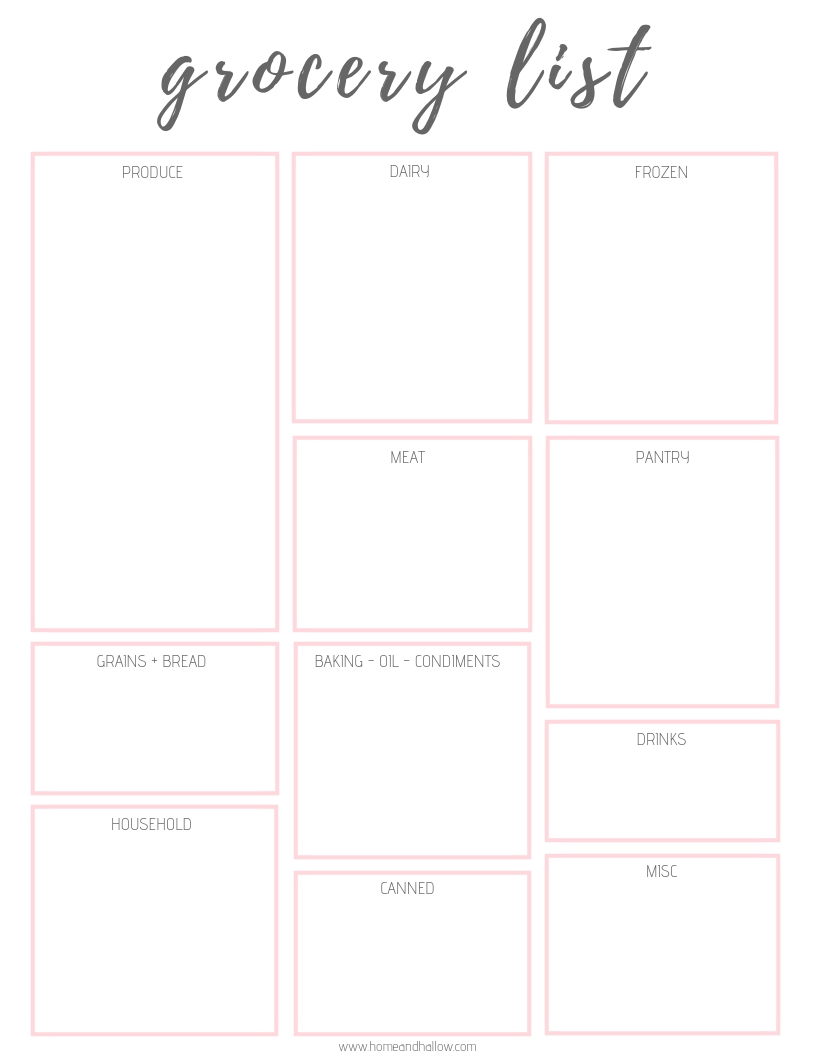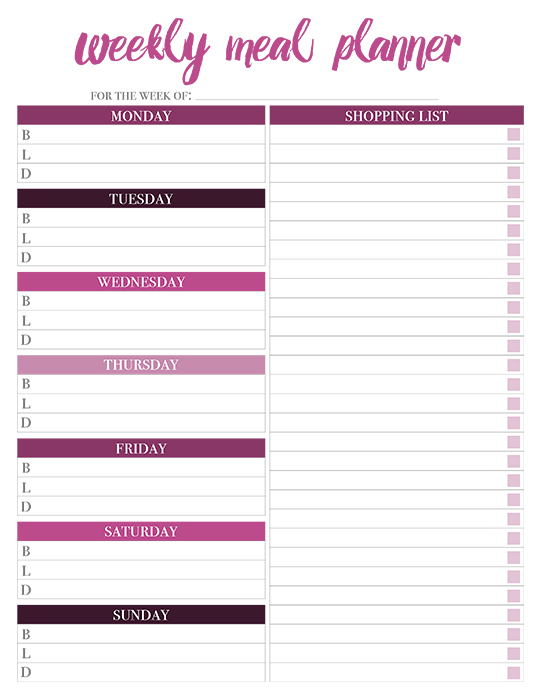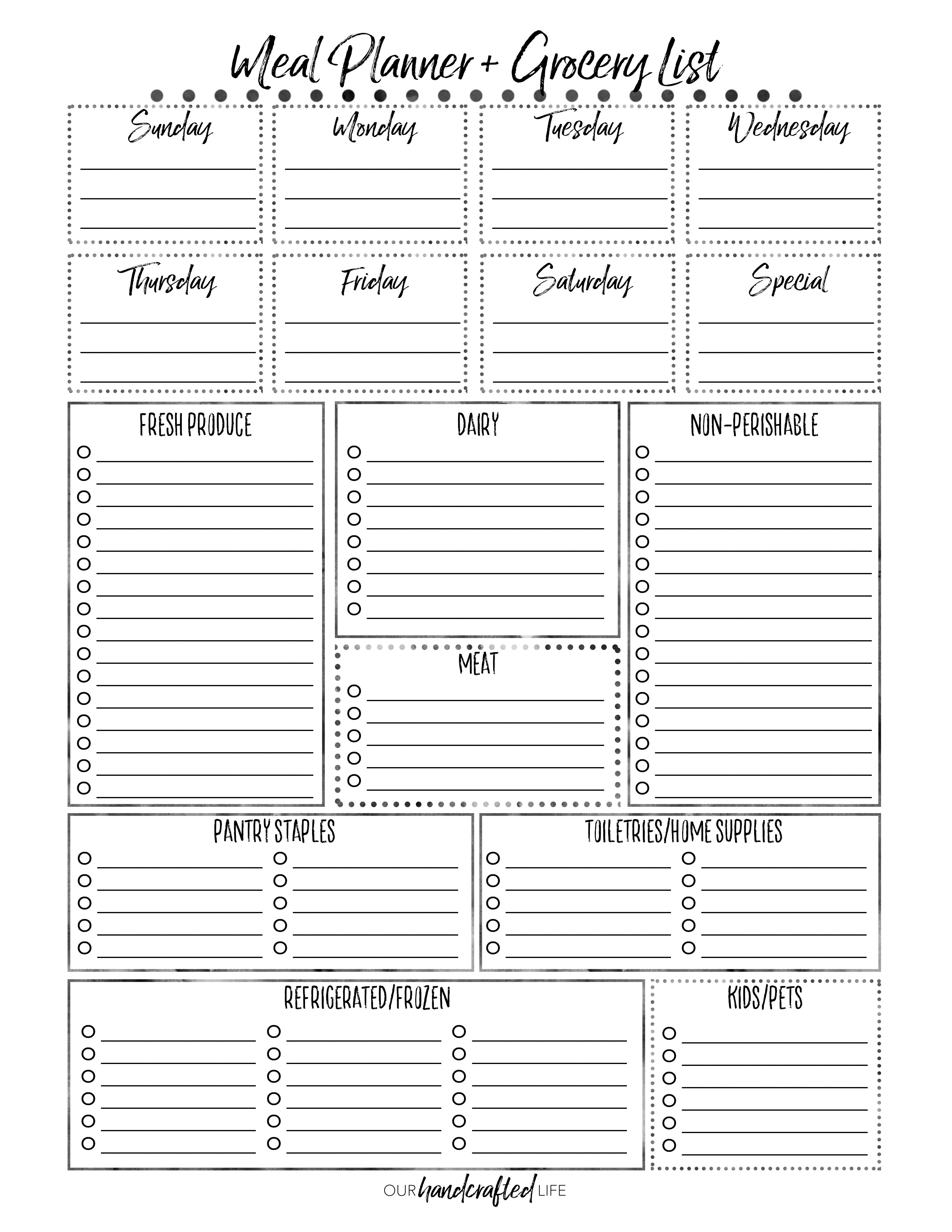A meal planner with a grocery list helps organize meals and shopping efficiently. It saves time and reduces food waste.
Meal planning can transform your weekly routine. By outlining meals in advance, you can make healthier choices and avoid last-minute takeout. A grocery list complements meal planning by ensuring you buy only what you need. This eliminates unnecessary purchases and keeps your budget in check.
Organizing meals and groceries also reduces stress, making cooking more enjoyable. Families can benefit from balanced meals, and individuals can stick to dietary goals. Embracing a meal planner with a grocery list fosters a more organized, healthy, and cost-effective lifestyle.
Introduction To Meal Planning
Meal planning can save time, money, and stress. It helps you to prepare meals ahead of time, ensuring you have everything you need. A meal planner with a grocery list is a handy tool. It can make your life easier and more organized.
Benefits Of Meal Planning
Meal planning offers several benefits:
- Saves time: No more last-minute decisions about what to eat.
- Saves money: Less waste and fewer impulse buys.
- Healthier eating: You can plan balanced meals.
- Reduces stress: Know exactly what to cook every day.
Common Challenges
While meal planning is useful, some challenges can arise:
- Time-consuming: Planning meals and making lists can take time.
- Variety: It can be hard to come up with new meal ideas.
- Sticking to the plan: Unexpected events can disrupt your plans.
- Storage issues: Ensuring you have space for all ingredients.
Using a meal planner with a grocery list can help overcome these challenges. It keeps you organized and on track.
Setting Up Your Meal Planner
Setting up a meal planner can simplify your life. It helps you eat healthier and save time. Follow these easy steps to get started.
Choosing A Format
First, decide on a format for your meal planner. You can choose between digital and paper formats. Both have their benefits. Here are some options to consider:
| Format | Pros | Cons |
|---|---|---|
| Digital |
|
|
| Paper |
|
|
Tools And Resources
Several tools can help you set up your meal planner. Here are some useful resources:
- Mobile Apps: Apps like Mealime and Yummly offer meal planning features.
- Websites: Sites like Allrecipes and Epicurious provide recipes and planning tools.
- Templates: Printable templates are available online for a quick start.
- Grocery List Apps: Apps like AnyList can help manage your grocery list.
Start with the resources that suit your needs. You can always switch later if needed.
Creating A Balanced Menu
Creating a balanced menu is essential for healthy eating. A balanced menu ensures that you get all the necessary nutrients. It also keeps meals interesting and enjoyable. Let’s explore some key aspects of creating a balanced menu.
Incorporating Nutrients
Every meal should include a mix of nutrients. This includes proteins, carbohydrates, fats, vitamins, and minerals. Here’s a simple table to guide you:
| Nutrient | Food Sources |
|---|---|
| Proteins | Chicken, fish, beans, tofu |
| Carbohydrates | Rice, bread, pasta, fruits |
| Fats | Avocado, nuts, olive oil |
| Vitamins | Vegetables, fruits, dairy |
| Minerals | Leafy greens, nuts, seeds |
Variety And Preferences
It’s important to have variety in your meals. This keeps your diet interesting and ensures you get different nutrients. Here are some tips:
- Rotate different sources of proteins like chicken, fish, and beans.
- Mix different vegetables and fruits every week.
- Try new recipes and cooking methods.
Consider personal preferences and dietary needs. This makes meal planning enjoyable and sustainable. Here’s a simple meal plan example for one day:
- Breakfast: Oatmeal with fruits and nuts
- Lunch: Grilled chicken salad with mixed greens
- Dinner: Baked salmon with quinoa and steamed vegetables
- Snacks: Yogurt, fresh fruit, or a handful of nuts
By following these guidelines, you can create a balanced and enjoyable menu. Happy meal planning!

Credit: homeandhallow.com
Designing Your Grocery List
Creating a grocery list is an art. It helps you save time and money. A well-organized list ensures you get everything you need. It also reduces food waste. Let’s explore how to design your grocery list effectively.
Categorizing Items
Categorizing items is crucial for a smooth shopping experience. It helps you find items faster in the store. Use these categories:
- Fruits and Vegetables: Apples, bananas, carrots, spinach
- Dairy: Milk, cheese, yogurt, butter
- Meat and Seafood: Chicken, beef, fish, shrimp
- Pantry Staples: Rice, pasta, canned beans, spices
- Baked Goods: Bread, rolls, bagels, muffins
- Beverages: Juice, soda, tea, coffee
Estimating Quantities
Estimating quantities helps avoid overbuying or underbuying. Here are some tips:
- Check Recipes: Note the quantity needed for each ingredient.
- Consider Meal Portions: Estimate how many servings you need.
- Factor in Leftovers: Plan for extra portions if needed.
- Account for Storage: Ensure you have space to store bulk items.
Here is a sample table for estimating quantities:
| Item | Quantity | Unit |
|---|---|---|
| Chicken Breast | 4 | pieces |
| Milk | 2 | liters |
| Apples | 6 | pieces |
| Rice | 1 | kilogram |
By categorizing items and estimating quantities, you make grocery shopping easy. Your meal planner and grocery list work together for a stress-free week.
Shopping Tips
Shopping for groceries is more efficient with a meal planner and grocery list. Here are some smart shopping tips to help you save money and eat healthy.
Budget-friendly Choices
Make smart choices to keep your grocery bill low. Here are some tips:
- Plan meals based on sales and discounts.
- Buy store brands instead of name brands.
- Purchase items in bulk for a lower price per unit.
- Use coupons to save money on essentials.
- Compare prices across different stores.
Seasonal And Local Produce
Eating seasonally and locally offers many benefits:
- Fruits and vegetables are fresher and taste better.
- Seasonal produce is often cheaper.
- Local foods reduce the carbon footprint.
- Support local farmers and the community.
Here is a quick guide to seasonal produce:
| Season | Fruits | Vegetables |
|---|---|---|
| Spring | Strawberries, Pineapple | Asparagus, Spinach |
| Summer | Watermelon, Peaches | Tomatoes, Zucchini |
| Fall | Apples, Grapes | Squash, Sweet Potatoes |
| Winter | Oranges, Kiwi | Broccoli, Kale |
Make a list before heading to the store. Stick to it to avoid impulse buys. Happy shopping!

Credit: www.livecrafteat.com
Meal Prep And Storage
Meal prepping saves time and ensures healthy eating. With a meal planner and grocery list, it’s easy to stay organized. Let’s dive into the essentials of meal prep and storage.
Batch Cooking
Batch cooking involves preparing large quantities of food at once. This method saves time throughout the week.
Here are steps to follow for batch cooking:
- Choose recipes that freeze well.
- Cook in large pots or pans.
- Divide meals into portions.
A simple example:
| Day | Meal |
|---|---|
| Monday | Chicken Stir-fry |
| Tuesday | Beef Chili |
| Wednesday | Vegetable Soup |
Proper Storage Techniques
Proper storage techniques keep food fresh and safe. Follow these tips to ensure meals last longer:
- Use airtight containers.
- Label with dates.
- Store in the fridge for up to 4 days.
- Freeze for longer storage.
Remember:
- Reheat food to the right temperature.
- Never refreeze thawed meals.
These steps help maintain food quality and safety.
Adjusting For Special Diets
Planning meals can be tricky, especially with special dietary needs. A meal planner with a grocery list can make this process easier. It helps you cater to various dietary restrictions and preferences. This section focuses on adjusting meal plans for special diets.
Allergies And Intolerances
Food allergies and intolerances need careful attention. Common allergens include nuts, dairy, and gluten. Ensure you check food labels and avoid cross-contamination.
| Allergen | Substitute |
|---|---|
| Nuts | Seeds (like sunflower seeds) |
| Dairy | Plant-based milk (like almond milk) |
| Gluten | Gluten-free grains (like quinoa) |
Here are a few tips to handle allergies and intolerances:
- Read ingredient lists carefully.
- Use dedicated kitchen tools for allergen-free meals.
- Plan simple and natural meals.
Vegetarian And Vegan Options
Vegetarian and vegan diets are becoming more popular. They require careful planning to ensure balanced nutrition.
Here are some protein-rich foods for these diets:
- Legumes (like lentils and chickpeas)
- Tofu and tempeh
- Nuts and seeds
- Quinoa and other whole grains
Plan meals with a variety of vegetables, fruits, and grains. Use the meal planner to create balanced meals for the week. This ensures you get all essential nutrients.
Remember to include these important nutrients in vegetarian and vegan diets:
- Iron (found in spinach, lentils, and fortified cereals)
- Calcium (found in fortified plant milks and leafy greens)
- Vitamin B12 (found in fortified foods and supplements)
A meal planner with a grocery list helps you stay organized and ensures you meet dietary needs. It saves time and reduces stress when planning special diets.
Maintaining Consistency
Consistency is the key to successful meal planning. Sticking to a plan ensures you eat healthier and save time. A meal planner with a grocery list helps maintain this consistency.
Tracking Progress
Tracking your progress is essential. It helps you stay on track with your meal plans. Note what you eat each day. This information can be useful later.
| Day | Meal | Notes |
|---|---|---|
| Monday | Grilled Chicken Salad | Added extra veggies |
| Tuesday | Spaghetti Bolognese | Used whole wheat pasta |
Use a table to track meals and notes. This makes it easy to see patterns.
Adapting To Changes
Plans do not always go smoothly. Adapting to changes is vital. Make adjustments to your meal planner as needed. Flexibility is important for long-term success.
- Replace unavailable ingredients.
- Switch meal days.
- Try new recipes.
Be prepared to adapt. This keeps your meal planning stress-free and enjoyable.

Credit: ourhandcraftedlife.com
Frequently Asked Questions
How Do I Make A Meal Plan And Grocery List?
Start by listing your meals for the week. Check recipes and note needed ingredients. Create a grocery list based on the meal plan. Organize the list by sections: produce, dairy, meats, etc. Stick to the list while shopping to avoid unnecessary purchases.
Is There An App That Takes Recipes And Makes Grocery List?
Yes, several apps can convert recipes into grocery lists. Popular options include Paprika, Yummly, and AnyList.
Is There An App That Will Meal Plan For Me?
Yes, apps like Mealime, Yummly, and Paprika offer meal planning features. They help you create customized meal plans.
What Are The 5 Rules In Planning Meals?
1. Balance nutrients with protein, carbs, and fats. 2. Include a variety of food groups. 3. Prioritize fresh, whole foods. 4. Control portion sizes for each meal. 5. Plan meals to match dietary needs and preferences.
Conclusion
A meal planner with a grocery list simplifies your life and saves time. It ensures balanced meals and reduces food waste. Start planning today to enjoy stress-free cooking and healthier eating. Embrace the convenience and efficiency of meal planning for a more organized lifestyle.
Happy cooking!
